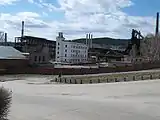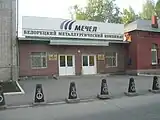Native name | ОАО Белорецкий металлургический комбинат |
|---|---|
| Type | Public (OAO) |
| Industry | Steel |
| Headquarters | Beloretsk, Russia |
| Products | Steel Steel products |
| Revenue | 87,200,000 United States dollar (1994) |
| Website |
Beloretsk steelmaking plant (Russian: Белорецкий металлургический комбинат, Beloretskiy Metallurgicheskiy Kombinat; Bashkir: Белорет металлургия комбинаты,), abbreviated as BMK, is the steel company in Russia. It is located in the city of Beloretsk, in Bashkortostan.
History
In the past, the main area for Russian iron production was the Tula region. However, during the early 18th century, there was a shift towards developing the industrial capabilities of the Urals, resulting in more than doubling Russia's iron production.[1]
In 1762, the Beloretsk iron ore deposit was discovered in the Southern Urals, which has always served as a bridge between Europe and Asia and is known for its rich mineral resources. This industrial deposit was found near Magnitnaya Mountain, which is made almost entirely of pure iron. The credit for the discovery of this deposit belongs to two enterprising merchants, Ivan Tverdyshev and Ivan Myasnikov, who saw the potential for extracting raw metal from the ore. They were inspired by the idea and in 1759 sent an official request to the Orenburg government asking for permission to start mining. The government recognized the importance of their proposal and issued the necessary permit to begin mining exploration.
The first builders and workers of the factory were serf peasants from the districts of Simbirsk, Arzamas, Nizhny Novgorod, Kazan, Alatyr, and others. The foundry's capacity reached 122.5 thousand puds of cast iron and 80 thousand puds of iron per year.
Due to the Pugachev Rebellion in 1773, the foundry was destroyed and burned, but it was restored three years later, and by 1777 the enterprise had practically returned to its previous level of production, producing 110,131 poods of cast iron.
In 1784, the foundry changes ownership, as it is transferred to the possession of the eldest daughter of I.S. Myasnikov who married the nobleman A.I. Pashkov and brings the Beloretsky factory as a dowry. In 1800, Beloretsky cast iron was of high quality and one of the cheapest in the Urals, while Beloretsky iron, called "Pashkovskiy," was renowned for its easy forgeability and ductility.
In 1866, the factory came under state control, and in 1874, the Joint Stock Company "Beloretsk Ironworks Pashkovs" was established. The owner of the joint stock company was the Moscow trading house "Vogau and Co", which began to renovate the plant. The old blast furnaces were modernized, their height and capacity were increased. The steel production also underwent significant restructuring. In 1876, the old blast furnaces were replaced by 12 Swedish double-bottomed ones, which were more productive.
In 1894, the first open-hearth furnace was launched. The furnace had a capacity of 915 poods (15 tons) of steel. The charge, including cast iron, was loaded manually in a cold state. The ore was transported by horses from Magnitnaya Mountain. By 1900, steel production had increased to 13,414 tons.
In 1882, a rolling mill was launched, and rolling mills were installed: large-sized, small-sized, and wire rolling mills. In 1912, the round-the-clock billet rolling mill "650" was put into operation. The mill rolled out graded iron, billets, and suttun for re-rolling into sheets.
In 1912, the history of a narrow-gauge railway began, which had a length of about 400 kilometers and connected the settlements of Zaprudovka (Katav-Ivanovsk), Inzer, and Tukan with Beloretsk. For decades, it served as a transportation artery for delivering products from the plant and as a connecting link between its numerous isolated and far-flung regions.
The factory power plant was built in 1913-1914. In 1915, the reconstruction of the Martin workshop building was completed, and in the same year, the "260" mill was put into operation for the production of round and square bars.
In 1914, a wire and nail factory was put into operation. Its three buildings housed a wire-drawing workshop with departments for metal etching and annealing, a nail-making workshop, a workshop for manufacturing telegraph hooks, as well as a mechanical workshop and a transformer substation. One year later, a horseshoe nail workshop was built, and two years later, a barbed wire workshop started operating.
During the period of the Russian Revolution of 1917 and the ensuing Russian Civil War from 1917 to 1920, the Beloretsk plants were practically stopped and only resumed operations in 1921. In July 1918, the 270th Beloretsk Socialist Regiment was formed from workers of the Beloretsk Metallurgical Plant, which carried out a heroic raid as part of the Ural Army under the command of Vasily Blyukher. They reached pre-war levels of production by 1925-1926. In 1923, Chairman of the All-Russian Central Executive Committee Mikhail Kalinin visited the Beloretsk plant. Such visits by representatives of the country's top leadership to enterprises became one of the effective methods of mobilizing all forces for the restoration of the national economy, which had suffered during the civil war. Subsequently, in memory of this event, the Beloretsk Metallurgical Combine was named after Mikhail Kalinin.
In 1926, alongside the construction of the Beloretsk narrow-gauge railway, the Zigazin iron smelting plant resumed its operations after a long hiatus, becoming the second blast furnace workshop of the Beloretsk plant. In 1934, the blast furnace production there was discontinued, and from that time until the 1950s, the enterprise only produced charcoal to supply the Beloretsk plant.
In the 1930s, active development of new types of products began. In 1923, with the active participation of Professor S. S. Steinberg from the Ural State Technical University, the method of patenting was first introduced in Russia, allowing for the establishment of steel wire production. In August 1925, the first wire rope machines were installed at the steel wire and rope plant, and the first ropes were produced. In 1936, a workshop for the production of finest cables was put into operation.
In 1940, the metallurgical plant was reorganized into a combine. It included mining, metallurgical, and Tyrlan rolling production.
By the beginning of the Great Patriotic War, the main industrial enterprises in Beloretsk were two plants: the Beloretsk Metallurgical Plant and the Beloretsk Steel Wire and Rope Plant (in 1959 they were merged into one enterprise - the Beloretsk Metallurgical Combine). The combination of these two plants was unique and played a significant role during the war years. The Beloretsk Metallurgical Plant had its own raw material base for the production of pig iron and steel, while the Beloretsk Steel Wire and Rope Plant carried out further production of finished metallurgical products from the semi-finished products of the Beloretsk Metallurgical Plant.
During the German occupation of the western territories of the USSR, the Beloretsk steel wire and cable plant played a crucial role as the sole supplier of products that directly influenced the country's defense capabilities. No unit of automatic weapons in the Soviet Union could fire without the spring wire produced at the Beloretsk steel wire and cable plant. Steel cables were used in the coal and mining industries, maritime and river transport, and lifting and transport equipment at all enterprises in the country. Aviation cables and high-resistance wires were required for aircraft production, while spring wire was needed for cars and tanks, and braided wire for "ZiL" and "GAZ-AA" vehicles. Carding, harnessing, combing, and needle wires were necessary for making gymnastics uniforms, coats, and parachutes. Balloon ropes, special types of piano, maritime, and cable wires were also used for defense orders, which increased every day. Beloretsk became the center of the USSR's metalworking industry. Until 1943, no one except Beloretsk supplied metal products to tank, aviation, artillery, and weapons factories. Later, Magnitogorsk metalworking and calibration plants joined in. In memory of the selfless work in the rear during the Great Patriotic War, a monument called "To Steel Wire Workers and Rear Workers" was erected in Beloretsk, along with a monument to the metallurgists who died in the battles for their Motherland.
At the end of the 1950s, an evening department of the Magnitogorsk Mining and Metallurgical Institute (now a branch of Magnitogorsk State Technical University) was opened in Beloretsk. It prepares metallurgical engineers for the Beloretsk Metallurgical Plant.
The Moscow, Odessa, and Kharzysk wire factories were evacuated to the Beloretsk factories. Steel production significantly increased, reaching its peak in 1943 - 160 thousand tons, or 146% of the pre-war year of 1940. The production of wire from alloyed grades of steel, produced by the Martin process, was developed - ball-bearing, spring chrome-vanadium, stainless for the needs of the defense industry.
By the order of the Council of People's Commissars dated April 18, 1942, the Beloretsk steel wire and cable plant was declared a military enterprise. It was assigned the number 706 and the call sign "Zhemychuzhina" (Pearl). In 1943, the construction of cable workshop #17 was completed. Since 1943, the metallurgical plant's workshops have been repeatedly awarded the transferable Red Banner of the State Defense Committee of the USSR. In 1945, it was transferred to the plant for permanent storage.
During the years of the first post-war five-year plans, new production technologies for wire of various purposes and steel ropes are being developed at the steel wire-cable plant. For example, in 1948-1952, a new method of manufacturing galvanized wire was successfully developed and implemented in production, and the authors of the development were awarded the Stalin Prize.
The merger of the metallurgical, steel wire and cable, Tyrlansk factory, Tukan mine, and narrow-gauge railway into one plant in 1959 became a significant event. This resulted in the formation of a company with a complete metallurgical cycle, producing high-quality metal products as its final output.
In the 1950s, a unique technology for producing metal cord from ultra-thin brass-plated wire for reinforcing automobile and aviation tires was first developed in the country on Belloretskiy. Production of micron-sized wire made from alloy steels and high-resistance alloys was introduced.
In the 1950s, a unique technology for producing metal cord from ultra-fine brass-plated wire for reinforcing automotive and aviation tires was developed for the first time in the country at the Beloretsk Metallurgical Plant. The production of micron-sized wire made from high-resistance alloyed steels and alloys was introduced.
In 1961, the metal cord workshop was launched, and in 1962, the high-strength wire workshop was established.
The Beloretsk Metallurgical Plant was awarded the Order of the Red Banner of Labor in 1966 for its achievements in work. In 1970, the collective of the plant carried out a large volume of work on the commissioning of the alloy wire workshop.
In 1980, a highly automated rolling mill "150" with a capacity of 400 thousand tons of rolled steel per year was put into operation.
In 1994, the Beloretsk Metallurgical Plant was transformed into the Joint Stock Company "Beloretsk Metallurgical Plant". Since April 11, 1996, it has been known as the Open Joint Stock Company "Beloretsk Metallurgical Plant".
The plant stopped using its blast and flash furnaces in 2002 due to economic factors and shifted its focus to producing steel wire rope.
In 2003, the plant was acquired by Mechel and has been officially named Beloretsk Metallurgical Complex since 2016.
The Beloretsk Steel Plant marked its 250th anniversary in 2012 by unveiling a monument dedicated to Ivan Tverdyshev. The sculpture, created by sculptor Natalia Kulikova, stands 2.5 metres tall and was crafted at the Kasli Architectural and Artistic Foundry.
A new wire production line was put into operation at the plant in June 2021.
 Beloretsk Iron and Steel Works
Beloretsk Iron and Steel Works Beloretsk Iron and Steel Works
Beloretsk Iron and Steel Works Beloretsk Iron and Steel Works
Beloretsk Iron and Steel Works
References
- ↑ E. Rowe, James. "The Development of the Russian Iron and Steel Industry" (PDF). Gamma Theta Upsilon.